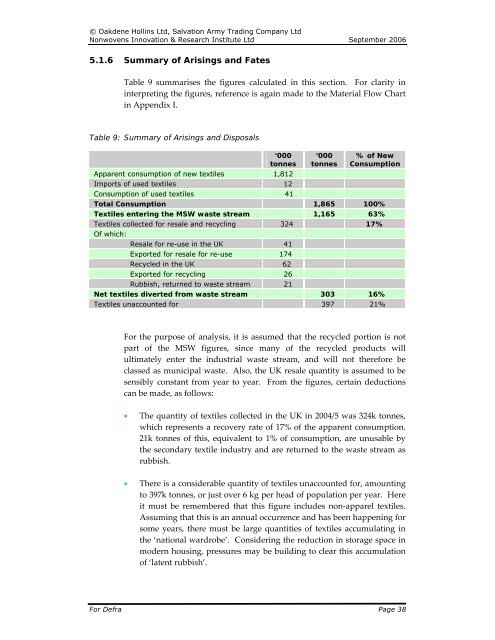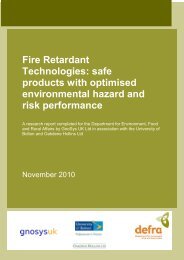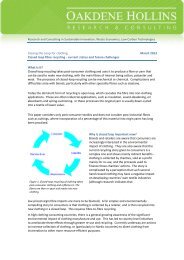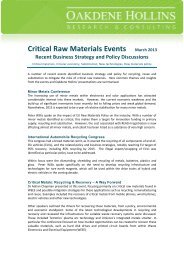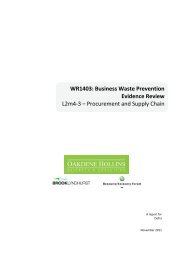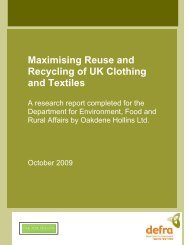Recycling of Low Grade Clothing Waste - Oakdene Hollins
Recycling of Low Grade Clothing Waste - Oakdene Hollins
Recycling of Low Grade Clothing Waste - Oakdene Hollins
You also want an ePaper? Increase the reach of your titles
YUMPU automatically turns print PDFs into web optimized ePapers that Google loves.
© <strong>Oakdene</strong> <strong>Hollins</strong> Ltd, Salvation Army Trading Company Ltd<br />
Nonwovens Innovation & Research Institute Ltd September 2006<br />
5.1.6 Summary <strong>of</strong> Arisings and Fates<br />
Table 9 summarises the figures calculated in this section. For clarity in<br />
interpreting the figures, reference is again made to the Material Flow Chart<br />
in Appendix I.<br />
Table 9: Summary <strong>of</strong> Arisings and Disposals<br />
‘000<br />
tonnes<br />
Apparent consumption <strong>of</strong> new textiles 1,812<br />
Imports <strong>of</strong> used textiles 12<br />
Consumption <strong>of</strong> used textiles 41<br />
‘000<br />
tonnes<br />
% <strong>of</strong> New<br />
Consumption<br />
Total Consumption 1,865 100%<br />
Textiles entering the MSW waste stream 1,165 63%<br />
Textiles collected for resale and recycling 324 17%<br />
Of which:<br />
Resale for re-use in the UK 41<br />
Exported for resale for re-use 174<br />
Recycled in the UK 62<br />
Exported for recycling 26<br />
Rubbish, returned to waste stream 21<br />
Net textiles diverted from waste stream 303 16%<br />
Textiles unaccounted for 397 21%<br />
For the purpose <strong>of</strong> analysis, it is assumed that the recycled portion is not<br />
part <strong>of</strong> the MSW figures, since many <strong>of</strong> the recycled products will<br />
ultimately enter the industrial waste stream, and will not therefore be<br />
classed as municipal waste. Also, the UK resale quantity is assumed to be<br />
sensibly constant from year to year. From the figures, certain deductions<br />
can be made, as follows:<br />
• The quantity <strong>of</strong> textiles collected in the UK in 2004/5 was 324k tonnes,<br />
which represents a recovery rate <strong>of</strong> 17% <strong>of</strong> the apparent consumption.<br />
21k tonnes <strong>of</strong> this, equivalent to 1% <strong>of</strong> consumption, are unusable by<br />
the secondary textile industry and are returned to the waste stream as<br />
rubbish.<br />
• There is a considerable quantity <strong>of</strong> textiles unaccounted for, amounting<br />
to 397k tonnes, or just over 6 kg per head <strong>of</strong> population per year. Here<br />
it must be remembered that this figure includes non‐apparel textiles.<br />
Assuming that this is an annual occurrence and has been happening for<br />
some years, there must be large quantities <strong>of</strong> textiles accumulating in<br />
the ‘national wardrobe’. Considering the reduction in storage space in<br />
modern housing, pressures may be building to clear this accumulation<br />
<strong>of</strong> ‘latent rubbish’.<br />
For Defra Page 38


